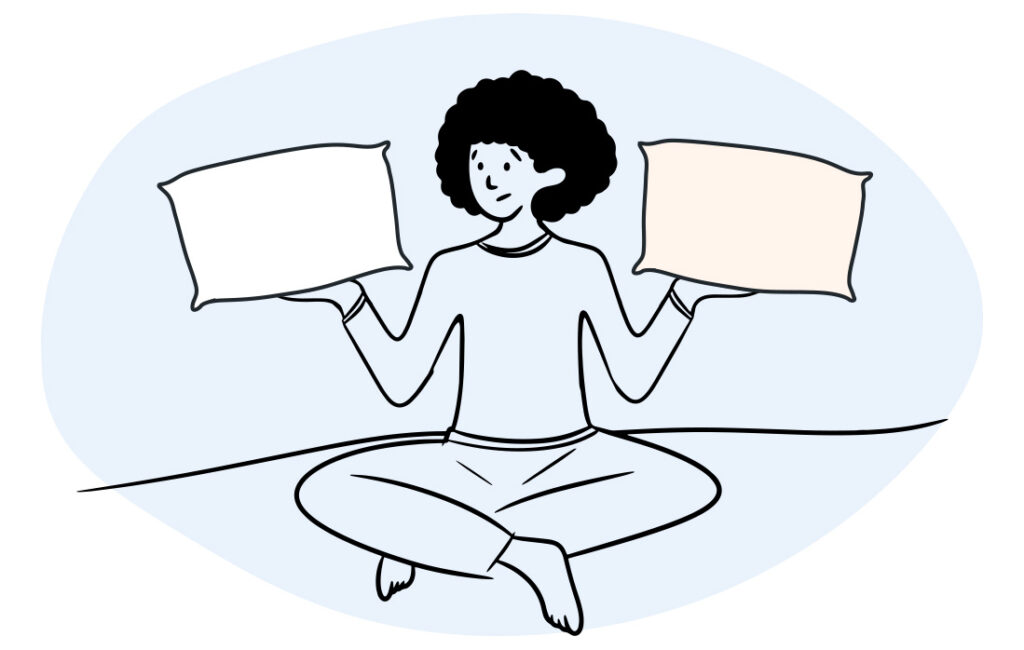Why Do Pillows Turn Yellow? Common Causes and How to Maintain a Fresh, Comfortable Sleep

If you’ve ever noticed yellow stains on your pillow, you’re not alone. It’s a common issue that many people encounter over time. But what causes this discoloration, and more importantly, what does it mean for your health and comfort?
In this article, we’ll explore why pillows turn yellow, what it signifies, and how you can prevent it to ensure a more comfortable and hygienic sleep experience.
Common Causes of Yellowing Pillows
-
Sweat and Body Oils
One of the primary causes of yellow stains on pillows is the natural oils your skin produces, combined with sweat. As you sleep, your body releases sweat and oils, which can seep into your pillow. Over time, these oils build up, resulting in yellowish discoloration on your pillow's surface. -
Saliva
If you tend to drool in your sleep, this can also contribute to yellow stains. Saliva, especially when mixed with sweat and body oils, can leave behind unsightly marks that are hard to ignore. -
Dead Skin Cells
As you sleep, your skin sheds dead cells. These can accumulate on your pillow, and when mixed with sweat and oils, they can contribute to yellowing. If you don't wash your pillow regularly, these particles build up and become more noticeable over time. -
Allergens and Dust Mites
Dust mites thrive in warm, humid environments like your bed. While they may not directly cause yellow stains, their presence in pillows can exacerbate discomfort, triggering allergies that affect your sleep. The accumulation of dust mites and allergens can indirectly contribute to pillow discoloration. -
Improper Pillow Care
Failing to clean or rotate your pillow regularly can lead to stains. If your pillow gets wet during cleaning or isn't fully dried before use, it may result in a yellowish tint due to the accumulation of moisture and residue from detergents.
What Does Yellowing Mean?

Yellow stains on your pillow generally signify a buildup of oils, sweat, and other bodily fluids. While this is often just a cosmetic issue, it can also signal the presence of bacteria, dust mites, and other allergens. Over time, these microorganisms can cause unpleasant odors, discomfort, and even skin irritation. In the long run, it may affect the quality of your sleep, leaving you feeling less rested and refreshed.
How Yellow Stains Impact Sleep Quality
A yellowed pillow isn’t just an eyesore—it can also impact the quality of your sleep in a number of ways:
-
Increased Allergies: The buildup of dust mites, bacteria, and allergens in your pillow can exacerbate allergy symptoms, including sneezing, coughing, and itchy eyes, all of which can disturb your sleep.
-
Uncomfortable Sleeping Surface: Stains and the accumulation of bodily fluids can make your pillow feel sticky or uncomfortable, preventing you from resting properly. A pillow that doesn’t feel fresh and clean can affect how well you sleep, leading to discomfort throughout the night.
-
Skin Irritation: As your pillow collects oils, saliva, and sweat, it can become a breeding ground for bacteria. Sleeping on a pillow with these bacteria can result in skin irritation, acne, or even fungal infections.
Recommended Pillow Case Cleaning Frequency
To prevent yellow stains and maintain a hygienic and comfortable sleeping environment, it’s essential to clean your pillow cases regularly. Ideally, you should wash your pillow cases once a week to remove sweat, oils, and any potential allergens. As for the pillows themselves, it’s a good idea to clean them every 3-6 months, depending on the material and usage.
-
Pillow Cases: Wash weekly in hot water (at least 60°C) to remove oils and bacteria.
-
Pillows: Wash every 3 to 6 months (or according to the care label) to remove any build-up and maintain pillow freshness.
How to Prevent Yellowing
To help keep your pillow fresh and clean:
-
Use a Pillow Protector: A pillow protector acts as a barrier between your pillow and sweat, oils, and allergens. It’s much easier to clean and replace than the entire pillow.
-
Wash Regularly: Wash your pillow and pillow case regularly, especially if you tend to sweat a lot during the night or if you suffer from allergies.
-
Dry Your Pillow Properly: Always dry your pillow thoroughly after washing to prevent moisture from lingering, which can lead to mildew or yellow stains.
Newentor’s Pillow Solutions: Comfort, Freshness, and Hygiene
At Newentor, we understand that comfort and cleanliness are essential for a good night’s sleep. That’s why our pillows are designed with both comfort and hygiene in mind.
-
Antibacterial Technology: Our pillows are infused with antibacterial materials to help prevent the growth of bacteria, dust mites, and other allergens. This ensures that your pillow stays fresh, hygienic, and comfortable for longer.
-
Comfortable and Supportive: Our pillows are crafted to offer optimal support for your neck and head, ensuring a restful and rejuvenating sleep experience. Whether you prefer a soft, medium, or firm pillow, Newentor has the perfect option for you.
-
Durable and Easy to Clean: Designed to stand the test of time, our pillows are not only durable but also easy to clean. Say goodbye to yellow stains and hello to a clean, fresh pillow every night.
Conclusion
Yellowing pillows are often the result of sweat, oils, saliva, and dust mites, and they can impact your sleep quality by causing discomfort, allergies, and skin irritation. By regularly washing your pillow cases and pillows, using a pillow protector, and choosing high-quality, antibacterial pillows like those from Newentor, you can ensure that your pillow stays fresh, comfortable, and hygienic.
Want to experience a cleaner, more comfortable pillow?




Leave a comment